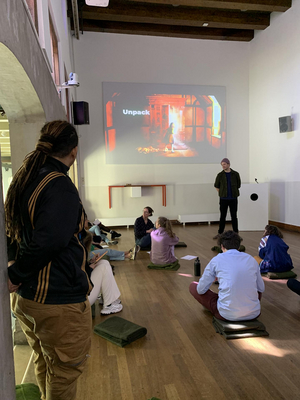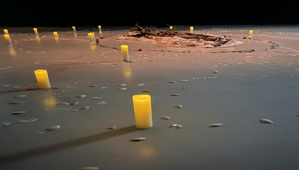Impression of Unlearning Space

The last of the Unlearning Saturdays was dedicated to space, Unlearning Space. In order to do so we started by entering a completely dark space where a voice asked us to descend into the unknown. The sound of the beginning gave way to silence until the moment the voice asked us to ascent again, and asking us to question ‘who we are’, ‘where we are’. Against a backdrop of singing birds we ‘surfaced’ and then left the Film Academy, walking behind each other and in silence on our way, with a detour to the Academy for Architecture.
Primary colours in space
There in the main space Puck van Dijk, the Artist in Residence of the day – theatre maker and philosopher – asked us to reflect on what we’d experienced in the spaces of darkness and silence. After that she introduced us to Machiel Spaan, architect and artist, whose sound installation, Ways of Space, had been built up in the space for us to experience. The installation had been the outcome of a residency Machiel had done in the Paris house of Theo van Doesburg, Dutch artist and founder of De Stijl, who was fascinated, among others, by the use of primary colours in space. Machiel’s installation was a sound response to Van Doesburg’s house and colour philosophy. We listened, stood, sat, and lied down to listen to the sound that came from four speakers in the space.
Mental space
The next Unlearning guest Puck had invited, Pim Schachtschabel, focused on mental space as another aspect of Space, and particularly on the value of ‘curiosity’ and how to become more adept at it. ‘Architecting curiosity’, he called it and then got us to do some exercises. Exercises that showed us the fun of concentrating on our surroundings and seeing things we hadn’t noticed before. Even those who walk the stairs and corridors of the Architecture academy all the time came across things they’d never seen before...

Eating spaces
Lunch was next. Again a huge surprise, as the cook had chosen a very particular place for us to eat: not at the table, but under it! Aside from this choice making sense as unlearning our conceptions of eating spaces, it referenced the fun children have in hiding from the grown-ups and playing and eating unseen. But it also related, according to Maureen, to a tradition in one of the Native American tribes to gather under the table when discussing urgent communal matters. Being seated under a table keeps the tempers down, as jumping up out of frustration would cause a headache….
After lunch, we gathered around the huge tree in the courtyard, where evidence of the previous Unlearning Saturday – Time – had been strung up around the tree: polaroids taken by the participants of interesting moments during the day.
Public space
Next, we gathered in the canteen of the building to be introduced to the idea of the Socratic Dialogue, which is all about asking questions, even stingy ones, to get others to think more deeply. A short Socratic exercise on indoor space prepared for one focussing on public space, which saw all participants, in groups of two, go for an hour long walk, keeping in Socratic conversation with each other only by sending each other voice messages.
When all had returned to the garden of the Academy, we evaluated the exercise, were handed a very appropriate text by George Perec and then sat down at a long table to share a farewell drink: Kombucha with a shot of mezcal. Thus the School of Unlearning went out with a bang….
Quote
Walls
I put a picture up on a wall. Then I forget there is a wall. I no longer know what there is behind this wall, I no longer know there is a wall, I no longer know this wall is a wall, I no longer know what a wall is. I no longer know that in my apartment there are walls, and that if there weren't any walls, there would be no apartment. The wall is no longer what delimits and defines the place where I live, that which separates it from the other places where other people live, it is nothing more than a support for the picture. But I also forget the picture, I no longer look at it, I no longer know how to look at it. I have put the picture on the wall so as to forget there was a wall, but in forgetting the wall, I forget the picture, too. There are pictures because there are walls. We have to be able to forget there are walls, and have found no better way to do that than pictures. Pictures efface walls. But walls kill pictures. So, we need continually to be changing, either the wall or the picture, to be forever putting other pictures up on the walls, or else constantly moving the picture from one wall to another.
George Perec
‘species of spaces’



















